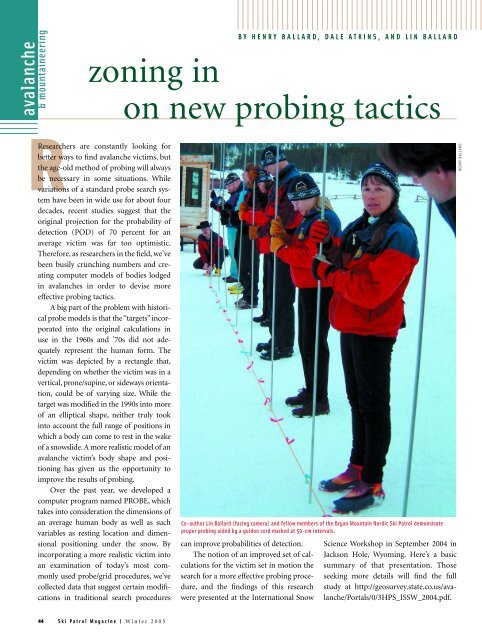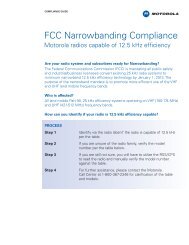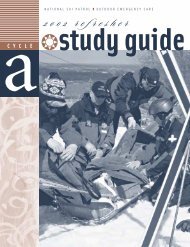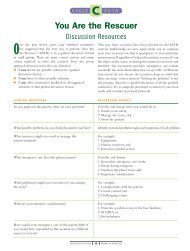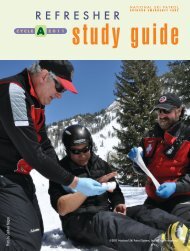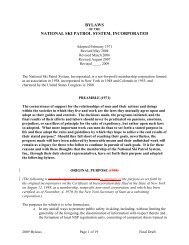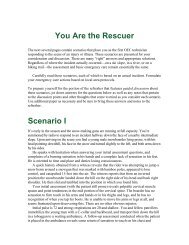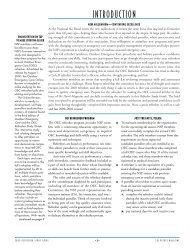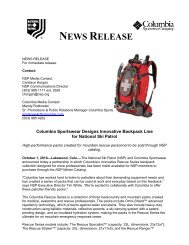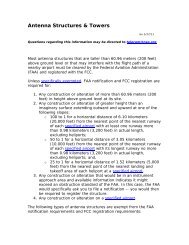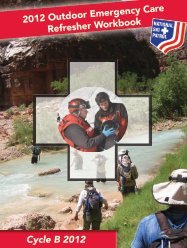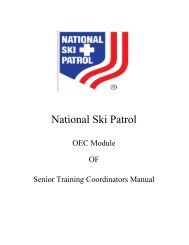Sierra Samaritans - National Ski Patrol
Sierra Samaritans - National Ski Patrol
Sierra Samaritans - National Ski Patrol
You also want an ePaper? Increase the reach of your titles
YUMPU automatically turns print PDFs into web optimized ePapers that Google loves.
avalanche<br />
& mountaineering<br />
BY HENRY BALLARD, DALE ATKINS, AND LIN BALLARD<br />
zoning in<br />
on new probing tactics<br />
R<br />
Researchers are constantly looking for<br />
better ways to find avalanche victims, but<br />
the age-old method of probing will always<br />
be necessary in some situations. While<br />
variations of a standard probe search system<br />
have been in wide use for about four<br />
decades, recent studies suggest that the<br />
original projection for the probability of<br />
detection (POD) of 70 percent for an<br />
average victim was far too optimistic.<br />
Therefore, as researchers in the field, we’ve<br />
been busily crunching numbers and creating<br />
computer models of bodies lodged<br />
in avalanches in order to devise more<br />
effective probing tactics.<br />
A big part of the problem with historical<br />
probe models is that the “targets” incorporated<br />
into the original calculations in<br />
use in the 1960s and ’70s did not adequately<br />
represent the human form. The<br />
victim was depicted by a rectangle that,<br />
depending on whether the victim was in a<br />
vertical, prone/supine, or sideways orientation,<br />
could be of varying size. While the<br />
target was modified in the 1990s into more<br />
of an elliptical shape, neither truly took<br />
into account the full range of positions in<br />
which a body can come to rest in the wake<br />
of a snowslide. A more realistic model of an<br />
avalanche victim’s body shape and positioning<br />
has given us the opportunity to<br />
improve the results of probing.<br />
Over the past year, we developed a<br />
computer program named PROBE, which<br />
takes into consideration the dimensions of<br />
an average human body as well as such<br />
variables as resting location and dimensional<br />
positioning under the snow. By<br />
incorporating a more realistic victim into<br />
an examination of today’s most commonly<br />
used probe/grid procedures, we’ve<br />
collected data that suggest certain modifications<br />
in traditional search procedures<br />
Co-author Lin Ballard (facing camera) and fellow members of the Bryan Mountain Nordic <strong>Ski</strong> <strong>Patrol</strong> demonstrate<br />
proper probing aided by a guidon cord marked at 50-cm intervals.<br />
can improve probabilities of detection.<br />
The notion of an improved set of calculations<br />
for the victim set in motion the<br />
search for a more effective probing procedure,<br />
and the findings of this research<br />
were presented at the International Snow<br />
Science Workshop in September 2004 in<br />
Jackson Hole, Wyoming. Here’s a basic<br />
summary of that presentation. Those<br />
seeking more details will find the full<br />
study at http://geosurvey.state.co.us/avalanche/Portals/0/3HPS_ISSW_2004.pdf.<br />
HENRY BALLARD<br />
44 <strong>Ski</strong> <strong>Patrol</strong> Magazine | Winter 2005


